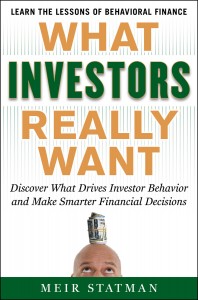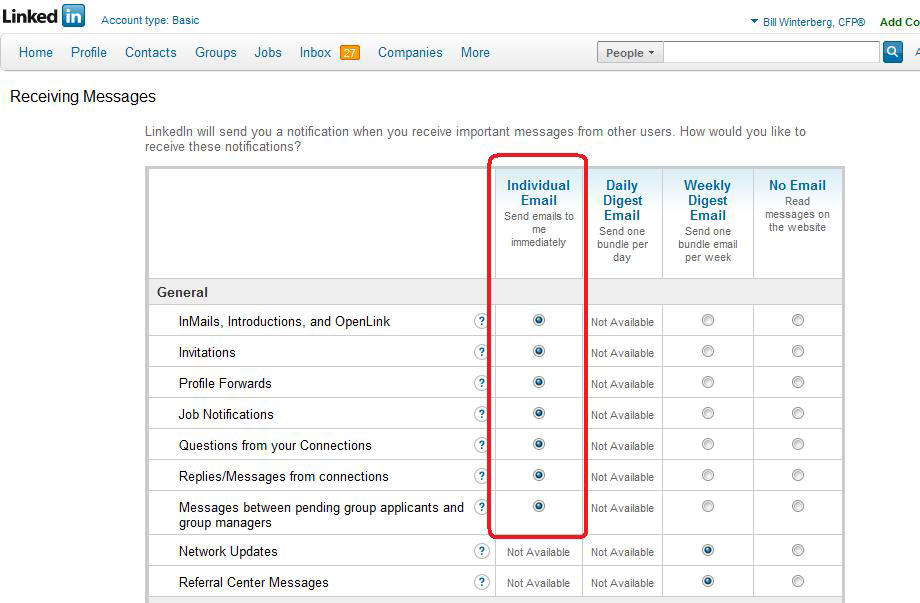 Fear prompts financial advisors’ clients to make bad decisions, as Meir Statman explains in his guest post below. He’s a renowned scholar in the area of behavioral finance, so I’m delighted to receive his guest contribution and a free copy of his new book, What Investors Really Want, thanks to my friends at McGraw-Hill.
Fear prompts financial advisors’ clients to make bad decisions, as Meir Statman explains in his guest post below. He’s a renowned scholar in the area of behavioral finance, so I’m delighted to receive his guest contribution and a free copy of his new book, What Investors Really Want, thanks to my friends at McGraw-Hill.
Client fears and financial advisor services
By Meir Statman
Many financial advisors encountered clients who were urged by fear to cash all their stocks in late 2008 and early 2009. Today, some advisors encounter clients who are urged by fear to replace stocks and bonds with gold.
Clients are often urged by cognitive errors and emotions to act in ways that damage their long term financial health. In that, clients are like patients who are urged by cravings to smoke or eat more than is prudent. Financial advisors are financial physicians. Good financial advisors listen carefully, empathize with clients fears, diagnose, educate, prescribe solutions, and follow up. Physicians do their work with the tools of science. So do financial advisors who teach clients the science of financial markets and the science of human behavior.
We know from the science of human behavior that we are less willing to take risk when we are frightened than when we are calm. In one experiment, a group of students were offered money to stand before the class the following week and tell a joke. A flat joke can be embarrassing, so it is not surprising that some students who agreed to tell a joke withdrew in fear when the time came to stand and tell a joke. But students who were frightened were more likely to withdraw than students who were not. Half the students in the experiment were shown a fear-inducing film clip from The Shining, Stanley Kubrick’s classic horror film, before deciding whether to tell a joke or withdraw. It turned out that a greater proportion of them withdrew.
Fear misleads us to avoid risk even when it is wise to take risk. Here is an investment game: I’ll toss a coin right before your eyes. If it comes out heads, I’ll pay you $1.50. If it comes out tails, you’ll pay me $1.
We’ll play 20 rounds of this game. Before each round you can choose to participate or sit it out. Ready? Suppose that you have lost three dollars in the first three rounds because all three tosses came out tails. Do you choose to participate in the fourth round or do you choose to sit out?
Three losses in a row would arouse fear in normal investors. Many choose to sit out the fourth round. But there is no good reason to be afraid because the game is stacked in favor of those who play all 20 rounds. In each round we have a 50/50 chance to lose $1 or gain $1.50. Our maximum loss is $20 while our maximum gain is $30. And even if we lose, a $20 loss is hardly catastrophic. Yet brain-damaged players were more reasoned at the game than normal players. Undeterred by fear, brain-damaged players played more rounds of the game than normal players and won more money.
There is a lesson here for advisors and clients. Fear grips us when we watch our portfolios day by day and see so many losing days. Fear grips us even more strongly when we watch losses in our portfolios over many months or even years, as happened in 2008 and early 2009. Fear urges us to sell our stocks and invest the money in gold or put it under a mattress. The fear of clients is normal, and financial advisors can counter it by teaching clients the science of human behavior.
Meir Statman is the Glenn Klimek Professor of Finance at the Leavey School of Business, Santa Clara University, and Visiting  Professor at Tilburg University in the Netherlands and the author of What Investors Really Want (McGraw-Hill). His research on behavioral finance has been supported by the National Science Foundation, CFA Institute, and Investment Management Consultants Association (IMCA) and has been published in the Journal of Finance, Financial Analysts Journal, Journal of Portfolio Management, and many other publications. A recipient of two IMCA Journal Awards, the Moskowitz Prize for Best Paper on Socially Responsible Investing, and three Graham and Dodd Awards, Statman consults with many investment companies and presents his work to academics and professionals in the U.S. and abroad. Visit his blog http://whatinvestorswant.wordpress.com/
Professor at Tilburg University in the Netherlands and the author of What Investors Really Want (McGraw-Hill). His research on behavioral finance has been supported by the National Science Foundation, CFA Institute, and Investment Management Consultants Association (IMCA) and has been published in the Journal of Finance, Financial Analysts Journal, Journal of Portfolio Management, and many other publications. A recipient of two IMCA Journal Awards, the Moskowitz Prize for Best Paper on Socially Responsible Investing, and three Graham and Dodd Awards, Statman consults with many investment companies and presents his work to academics and professionals in the U.S. and abroad. Visit his blog http://whatinvestorswant.wordpress.com/











